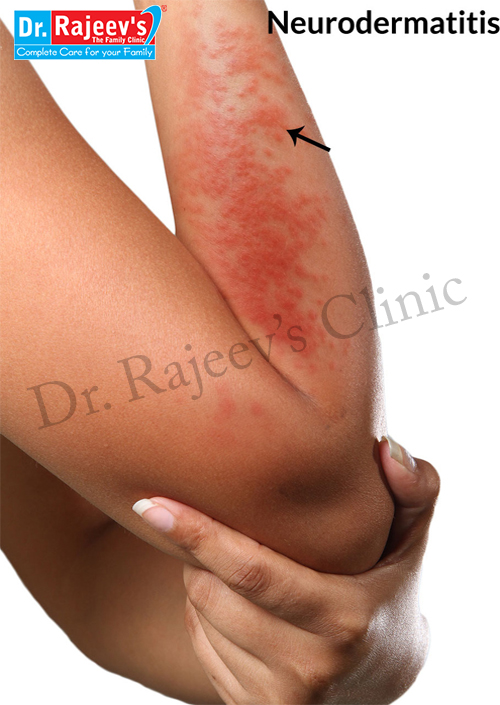

Neurodermatitis is also known as lichen simplex. It is commonly known as scratch dermatitis. It is a chronic disease characterized by itching and/or scaling. It starts with localized itching, but scratching increases itching and makes it more intense. Because of this cycle of chronic itching and scratching, the skin may become thick and leathery.

Generally, the cause is not known. Stress, anxiety can be triggering factors for it. Most of the times itching begins with something that simply rubs or irritates the skin, such as tight clothing or a bug bite. As patient starts scratching, itching increases more and the cycle goes on till skin becomes leathery.
Diagnosis is based on skin's appearance and a history of itching and scratching. Following tests can rule out other causes.
Skin biopsy - To rule out other conditions, such as lichen planus, eczema, psoriasis, that may mimic neurodermatitis.
Conventional treatment of neurodermatitis is directed at controlling itching and dryness of skin, and to prevent and reduce secondary infection. It gives short lasting results. It does not treat the root cause of disease.
Steroids and antihistamines – It suppresses itching may lead to aggressive flare up.
Antibiotics - Antibiotics are used to control secondary infection and inflammation of the lesion.
Antidepressants or anti-anxiety – In case of stress-related itching.
Moisturizers - To retain moisture in the skin. E.g. Petroleum jelly, moisturizing soaps, etc.
Homeopathic treatment for Neurodermatitis is strongly suggested.
Arsenicum album : People who need this remedy usually are anxious, restless, and compulsively neat and orderly. The skin is dry, itches, and burns intensely. Scratching can make the itching worse, and applying heat will bring relief. Indigestion with burning pain and a general feeling of chilliness are often seen when Arsenicum is indicated.
Calcarea carbonica : This remedy is suited to people who are chilly with clammy hands and feet, and tend to develop eczema and cracking skin that is worse in the wintertime. They are easily fatigued by exertion, and feel anxious and overwhelmed if ill or overworked. Cravings for sweets and eggs, a sluggish metabolism, and a tendency toward weight problems are other indications forCalcarea.
Graphites : People likely to respond to this remedy have tough or leathery skin with cracks and soreness, and often have a long-term history of skin disorders (impetigo, herpes, etc.) The areas behind the ears, around the mouth, or on the hands are often cracked, with a golden oozing discharge that hardens into crusts. Itching is worse from getting warm in bed, and the person will often scratch the irritated places till they bleed. Difficulty concentrating, especially in the morning, is often seen in a person who needs Graphites.
Hepar sulphuris calcareum : This remedy may be helpful to very sensitive, chilly people whose eczema is extremely sore and becomes infected easily. The skin, especially on the hands and feet, looks chapped and deeply cracked and is very slow to heal. The person usually feels vulnerable and irritable, with a low resistance to illness and infection.
Mezereum : A person who needs this remedy often has strong anxiety, felt physically in the stomach. Intensely itching eruptions start as blisters, then ooze and form thick crusts, and scratching can lead to thickened skin. Cold applications often help the itch (although the person is chilly in general). A craving for fat and a tendency to feel better in open air are other indications for Mezereum.
Rhus toxicodendron : A person whose eczema has blisterlike eruptions that look red and swollen, itch intensely, and are soothed by hot applications may respond to this remedy. The person is restless from discomfort and often is very irritable and anxious. Muscle stiffness, relieved by warmth and motion, is also likely. A person who needs Rhus tox often craves cold milk.